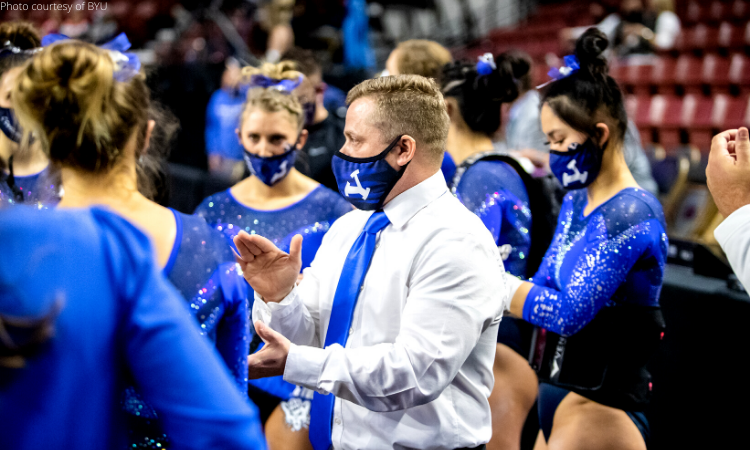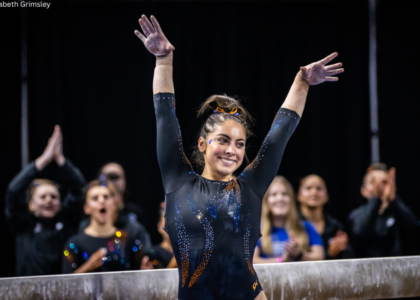As a member of the 2004 men’s U.S. Olympic team and later as an NCAA coach, BYU head coach Guard Young has spent his entire life focused on the sport of gymnastics. So it was somewhat of a surprise to learn a new sport has piqued his interest—college basketball.
While the two sports don’t have a lot in common, they might start to look more similar if Young has his way, beginning with basketball’s mandatory eight-week summer training.
Last June, the NCAA allowed DI basketball teams to conduct mandatory eight-week “training camps” during the summer. Young can’t stop thinking about this new rule, believing the sport of gymnastics needs a similar situation.
While the first instinct might be that more practice during the summer would result in burnout or more overtraining injuries, Young believes a summer season would actually make the sport safer. “For the safety of our sport, we’ve got to do something like that. We’ve got to move to an NCAA legislation that allows us to have required practices in the summer,” Young said.
After the end of the school year, most college gymnasts return home. Some student-athletes have jobs or out-of-state internships. Others take a family vacation. What about the gymnasts who stay on campus, either working or taking a summer class?
Under NCAA guidelines, a college coach cannot hold “mandatory practices” and cannot “coach” for those who remain on campus during the summer. Young envisions year-round training, with the summer focusing on a volunteer-based emphasis on conditioning.
Associate head coach Natalie Broekman, a member of the 1996-99 BYU gymnastics team, recalls going home for the summer and not doing gymnastics at all. She also realizes Young has a different perspective. “Guard comes from an Olympic mindset where he trained year-round and never stopped,” Broekman said.
Despite living a gymnastic-free summer, Broekman is on board with Young’s philosophy of training all year. “We feel like these girls are going to be healthier if they can keep their bodies moving and keep their skills ready to go in their back pocket. It makes the fall so much easier when we come back and we’re just ready to go,” Broekman said.
A Block System
When setting their summer schedule, the BYU staff had to consider facility logistics and NCAA rules. They also had to strategize the training schedule, optimizing the team’s physical and mental health.
The weight room is open twice a week, where the gymnasts condition from 7:30 to 8:30 a.m. Weight training is supervised by their strength and conditioning coach, who does not provide a report to Young as the training is voluntary. Young is not allowed in the weight room, even if he’s using the equipment for his own workout, as his presence would look like he’s taking roll call.
Being present in the gym is another story. For safety reasons, the NCAA rules allow Young and his assistant coaches in the gym. The staff is there to advise but not tell the student-athletes what to do.
In May and June, when many of the gymnasts are still taking classes, there is conditioning in the morning, followed by class and then the gym is open from 12 to 3 p.m. The schedule differs slightly in July and August, where instead of taking classes, the gymnasts might be teaching a gymnastic camp.
The staff also decided to test drive a “block” training schedule. Instead of training the entire 15 weeks of the season, they organized the calendar into three five-week blocks. Each block is followed by a week off, giving the gymnasts time to refuel.
The block schedule gives gymnasts enough time to reach obtainable, five-week goals. Young explains that looking at the entire 15 weeks of training is too overwhelming, making it difficult to see the micro successes that often lead to more significant achievements.
While Young believes goals are more accessible in a block, Broekman appreciates the mental health aspect of having a week off after each block, too.
The associate head coach empathizes with the ongoing demands of a long season, from September through the competition season. Broekman understands the mental weariness that comes with doing the same routine for four months straight, knowing many athletes need to get away and have a break.
The block system allows for a mental and emotional “reset.”
“It gives them permission to step away when they need, go on vacations, get out of the gy—but then come back and get the numbers. Keep your body moving so that when you come back in the fall, you’re not going to throw a Tkatchev for the first time and hurt your shoulder,” Broekman said.
Be Ready in September
When Young scheduled the summer session, he wasn’t thinking about the competition season in January. He was thinking of September.
Traditionally, when college gymnasts return in the fall, they get back into gymnastics shape and have to get their skills back. That’s not the September Young envisions. He explains he’s trying to educate his gymnasts of what September looks like and what is expected of them.
“When we start in September, you are going to start the way you ended the season,” he said. “The message is when you start in September, we are starting the season.”
Take the uneven bars as an example. Young tells his team that come September, the NCAA only allows 30 to 40 minutes per event. With such limited time, each gymnast has 10 minutes for the release move, 10 minutes for the high-to-low bar transition, and 10 minutes for the dismount. “We’re not doing a single bar mat in the pit with a million turns to warm up,” Young said.
They are expected to hit the ground flipping with skills ready to go. “If you’re not doing that level of gymnastics in September, with October and November there is no time to spend two months getting your skills back.”
Young explains that there is no time because the team is expected to have half of its routines ready by October. By November, they need to have a full set.
Broekman reiterates the expectations. “Our philosophy with our preseason training is we hit the ground running. By October, we’re having our first [intrasquad] in the gym, creating pressure situations to prepare for the season,” she said. “It gives them lots of opportunities so that we’re very comfortable on the competition floor once January hits.”
Broekman explains they do their intrasquad with individual events. For example, the first week of October might be just a beam intrasquad, where the entire team doesn’t have to be ready but the beamers need to be.
One way they create the pressure is by placing the meets in different venues. They plan five more intrasquads before hitting the competition floor, which they’ll hold in other parts of the campus, like the volleyball court and the track annex.
The Importance of Backups
The staff works with three types of gymnasts: returners, developmental athletes and backups.
Young believes the backups are the foundation of the team’s success.
Like a baseball team with a well-stocked bullpen, Young cannot overestimate the importance of those athletes. BYU has an extensive roster of 25 gymnasts (50% are walk-ons). While they may have 14 gymnasts in the beam lineup, that doesn’t mean 14 are ready to compete. During the season, many athletes get sidelined because of injury and concussion or COVID protocols.
“Those backups determine how long the success you’re going to have in competition. A lot of it is educating those kids on how important those roles are,” Young said.
In the last two seasons, the strongest gymnast was injured, but BYU finished strong. However, the team could cover and bring in replacements that would still compete at a high, and safe, level. Because what’s essential to Young is the safety of his team, which leads us back to the new college basketball rule. If there’s a required summer practice, it will be safer for the gymnast’s physical health and well-being.
“The joints, the ankles, the shoulders, the back, the knees—when you’re just doing basic tumbling, light tumbling and light vaulting, the body keeps its resistance and strength up to repel those forces,” Young said. “But when you take a complete break, it is hard on those joints. If you just do a little bit, you can maintain those forces on the body.”
READ THIS NEXT: Big 12 Conference Extends Invitation to BYU
Article by Kelly Feng
Like what you see? Consider donating to support our efforts throughout the year!




